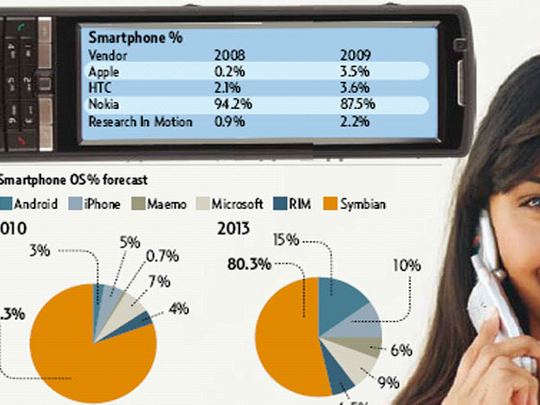
Dubai: The Middle East and African market for touchscreen mobile devices will more than double to touch 11.7 million in 2010, a 120.75 per cent increase from 2009 sales of 5.3 million, according to research firm Gartner.
"The iPhone is the vendor which brought multi-touch to the real world. Apple has shown the viability of capacitive touch technology in mobile phones, which enables more-natural, responsive and intuitive gestures," CK Lu, research analyst at Gartner, told Gulf News in telephone interview from Taiwan.
He predicts that capacitive and resistive touchscreens will coexist in the short term in mobile phones. Capacitive touch will be the mainstream technology; however, resistive touchscreens will around because of lower cost.
The current forecast for mobile phone sales in MEA this year is more than 140 million compared to 128.88 million last year, up more than 8.80 per cent.
The research firm is expected to revise its forecast for the region due to strong demand.
He said iPhones sold 424,000 units in MEA in 2009, a 1,342 per cent growth compared to 29,400 in 2008 while BlackBerry sold 264,800, an increase of 135 per cent compared to 112,600 in 2008.
"Many vendors are going a step further and beginning to deliver user interfaces (UIs) that are truly optimised for touch input. They are also increasing their software skills to deliver deeper integration of touch UIs with the underlying platform, rather than software overlays," Lu said.
However, vendors need to concentrate on delivering an experience rather than just a product. "Consumers won't buy a mobile device purely for the touch UI," said Lu, he added that touch technology is just an enabler, and ultimately, it is a compelling user experience which includes good UI design, applications and services — that will make or break a product.
By 2013, touchscreen mobile devices are expected to touch 66.1 million out of 173.1 million total phone sales.
"Vendors need to invest in expanding their UI design capabilities to offer uninterrupted experience and vendors should consider integrating touch with other form factors, such as numeric or Qwerty keypads, because touch UI cannot fulfil all kinds of operations," he said.
He said average selling prices will remain the same as last year, but more low-cost touchscreen phones will be launched this year.
Mobile features
Basic Phone: This is a voice-centric, entry-level mobile device costing up to $80 before subsidy with basic functionality targeted at emerging markets and first-time users and is often used for prepaid subscriptions.Enhanced Phone: A voice-centric mobile device with enhanced features such as camera, MP3 player, video player, Java support, calendar and contact synchronisation. These devices support data services, such as web browsing and multimedia messaging. Smartphone: Entry-Level: This smartphone is closer to an enhanced phone in specification and usage, but because it runs on an open operating system, it is classified as a smartphone. The device's primary focus is on voice communication. Smartphone Feature: This smartphone is optimised in its specification and features to support one or more primary functions like music, video, gaming, pictures, browsing, mobile TV, navigation, messaging. Compared to entry-level smartphones, these devices usually have larger displays, more powerful processors, more embedded memory and better battery capacity. These devices can have a touch screen to help the manipulation and consumption of content and data input. They can include an enhanced or full Qwerty keyboard to support rich messaging.












